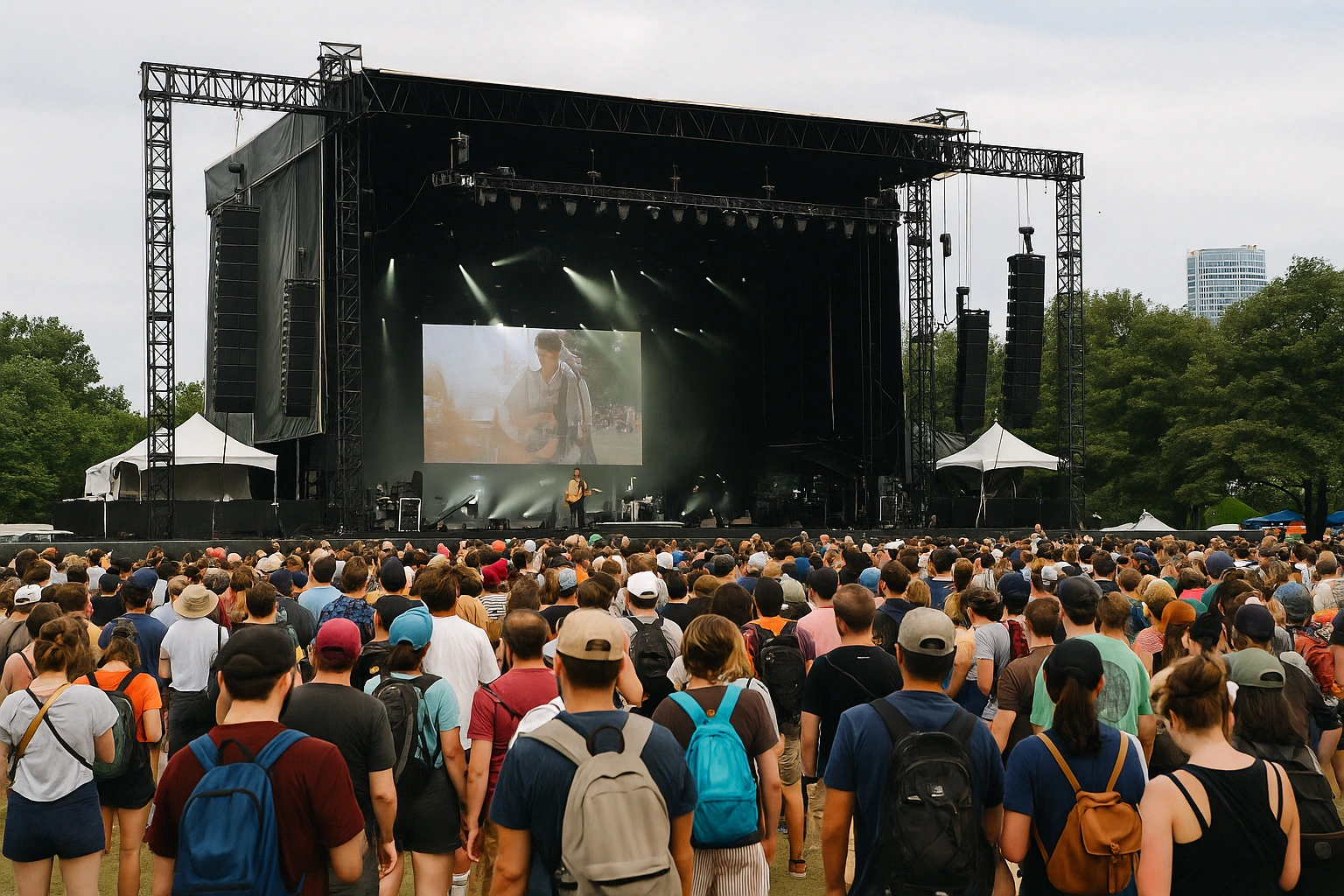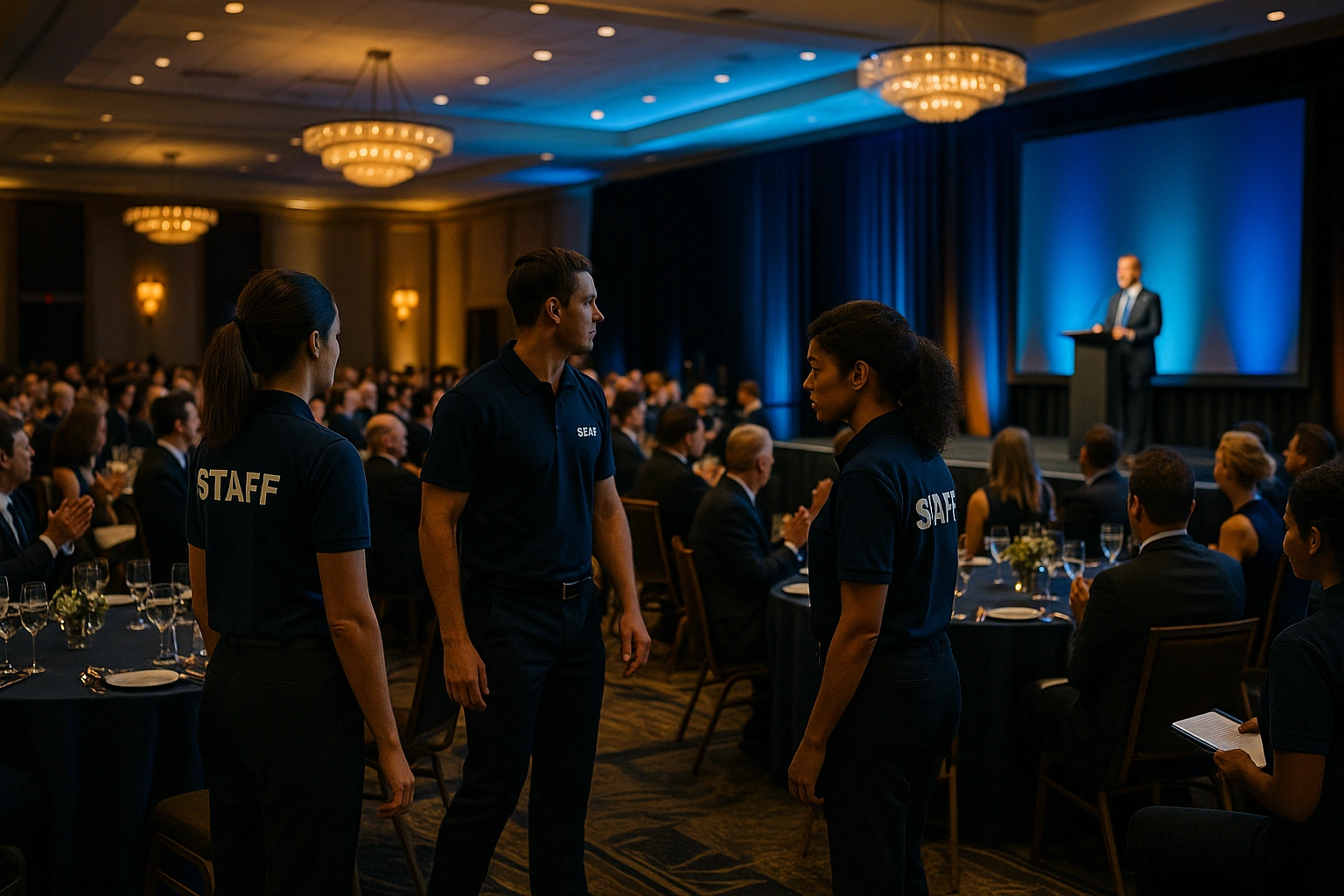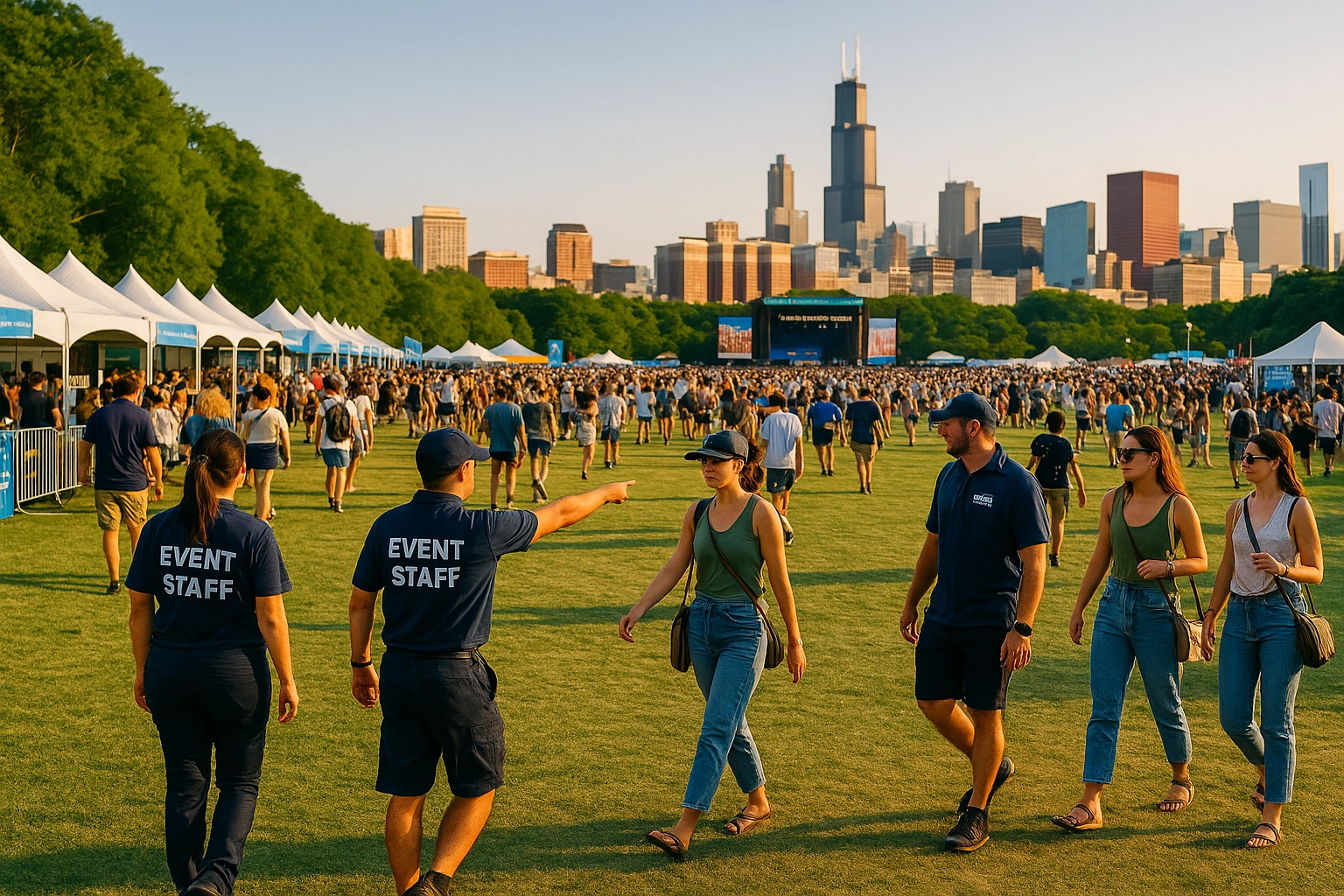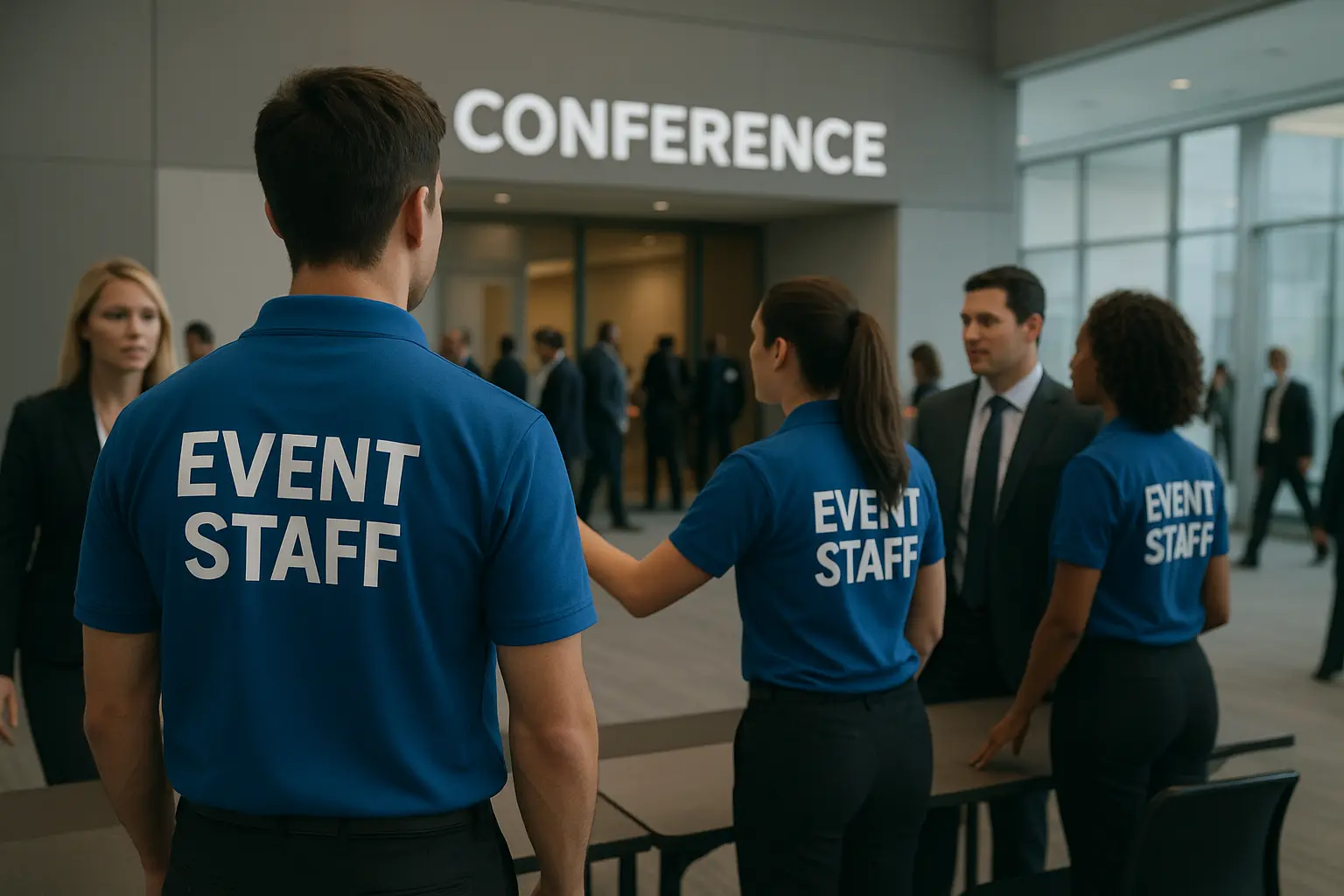At a Glance: Large-scale festivals succeed when staffing operates like a system, not a headcount. This article outlines ten critical errors that slow entry, inflate costs, and strain compliance, and shows how structured crew design restores predictability across major U.S. cities.
Why Festival Staffing Breaks Before the First Gate Opens
Behind the glamour of every large-scale festival lies an intricate staffing ecosystem. The U.S. festival economy exceeds five billion dollars annually, employing thousands of seasonal specialists across production, hospitality, and logistics. One missed rotation or late credential batch can cascade into crowding, vendor penalties, and sponsor dissatisfaction.
Cities compound complexity. Each market introduces different permit windows, heat profiles, and labor classifications. Unions in Chicago differ from vendor agreements in Las Vegas; Los Angeles builds across multiple venues while Nashville funnels crowds through narrow mixed-use corridors.
Staffing therefore functions as risk management, not labor procurement. The following ten mistakes repeatedly derail festivals nationwide—and the disciplined methods that eliminate them define operational excellence.

CEO Excerpt
“Every festival’s success comes down to one equation: preparation multiplied by people. When teams are trained, briefed, and empowered to make micro-decisions in real time, risk disappears. At Event Staff, we build systems that let human precision scale — so even when 50,000 guests arrive at once, the experience still feels effortless.” - CEO, Event Staff
1. Underestimating Arrival Flow and Ingress Timing
Guest arrival is the first live-stress test of planning. In Austin, Chicago, and New York, gates see density spikes of 150 percent within thirty minutes of headline sound checks. When crew placement ignores data from previous years, scanners bottleneck and crowd tension rises.
The Event Safety Alliance (2023) reports that unmanaged ingress adds an average 22 percent overtime cost and increases risk of crowd compression by 18 percent. Each minute of unresolved delay multiplies security and vendor costs.
How Event Staff Avoids It
Event Staff models ticket-release curves and weather patterns to predict surge windows. Gate teams are doubled during the first hour of opening and taper as volume stabilizes. Supervisors monitor throughput via real-time dashboards and redeploy rovers the moment flow slows, keeping average entry below seven minutes per guest.
2. Copy-Pasting Staffing Plans Across Different Markets
A template that fits Las Vegas cannot survive Boston’s 10 p.m. park curfew. Hosts often recycle successful plans from one city to another, ignoring venue geometry, local labor caps, and traffic law. The result is mismatched shift lengths, illegal overtime, and inefficient teardown sequencing.
Inconsistent local adaptation strains police coordination and insurance compliance. A 2024 Freeman benchmark noted that festivals with misaligned regional plans logged 30 percent more last-minute crew changes, driving cost volatility.
How Event Staff Avoids It
Each city has its own operational dossier detailing curfews, union clauses, and transit choke points. Regional managers coordinate directly with city permitting offices and emergency services to verify ratios. Staffing grids are rebuilt per site so every shift honors local regulation while sustaining national quality metrics.
All staff at Event Staff receive pre-event digital handbooks outlining maps, emergency codes, and service expectations. Ten-minute refreshers before every shift re-anchor communication standards.
3. Ignoring Shift Overlaps and Fatigue Cycles
Human energy sets the real schedule. Cities like Las Vegas, Miami, and Phoenix push crews through heat, noise, and overnight rotations that degrade alertness faster than clock hours indicate. Without overlaps, coverage gaps appear during handoffs when risk is highest.
PCMA Convene (2024) found that fatigue after eight continuous hours doubles on-site error rates, and hydration deficits reduce decision speed by up to 15 percent. Fatigue costs more than additional labor; it erodes situational judgment and guest safety.
How Event Staff Avoids It
Event Staff designs overlapping thirty-minute buffers between shifts. Supervisors track exertion through digital check-ins and schedule hydration cycles every ninety minutes. Crews receive pre-event wellness briefings, and any zone reaching heat-index thresholds triggers automatic relief deployment. The practice preserves precision during the longest operating windows.

4. Minimal Onboarding and Localized Briefings
Many organizers compress orientation into a single generic session. But cities like New York, San Francisco, and Chicago require site-specific credential paths, local language sensitivity, and unique evacuation protocols. A one-size briefing cannot prepare teams for multi-venue coordination.
Poor onboarding leads to inconsistent guest handling and uneven tone. Each miscommunication lengthens queue time and damages the perception of professionalism.
How Event Staff Avoids It
All staff at Event Staff receive pre-event digital handbooks outlining maps, emergency codes, and service expectations. Ten-minute refreshers before every shift re-anchor communication standards. Supervisors conduct live walk-throughs of new zones so every crew understands boundaries, tone, and escalation orders before guests arrive.
5. Unclear Chain of Command and Escalation Path
When roles overlap without hierarchy, operations slow under pressure. Hybrid events in Houston, Seattle, and Washington D.C. combine volunteers, vendors, and contracted security whose command lines rarely meet. Without a visible chain, small incidents escalate into public disruptions.
Ambiguity increases response time and confuses accountability logs, exposing organizers to legal risk. One delay in crowd control can ripple through headliner schedules and union overtime budgets.
How Event Staff Avoids It
Each site follows a strict one-to-ten supervision ratio. Leads escalate through zone captains to a single operations manager equipped with live radio priority. Staff rosters list names and escalation tiers on every tablet. This vertical clarity compresses decision cycles from minutes to seconds.
Data is the only memory an event retains. Festivals in Seattle, Miami, and New York frequently skip structured debriefs once teardown ends. Without captured metrics, planning resets to guesswork next season.
6. Neglecting Weather and Venue Geography
Environment dictates stamina. Phoenix, Denver, Orlando, and San Diego pose extremes of heat, altitude, humidity, and distance. When schedules ignore these variables, efficiency collapses long before staff numbers do.
The Event Industry Council (2023) measured a 17 percent performance loss above 95°F and similar decline at Denver’s mile-high elevation without acclimation. Weather-blind rosters produce uneven shift strength and safety incidents.
How Event Staff Avoids It
Meteorological data and venue maps are layered into scheduling software. Routes are plotted to minimize uphill or unshaded travel. Rotations shorten as heat index rises, and each zone includes stocked hydration kits and first-aid relief. The method turns climate into a managed variable, not a crisis trigger.

7. Over-Reliance on Volunteers for Critical Roles
Volunteers are invaluable for community engagement but unreliable for mission-critical execution. In Austin, New Orleans, and Atlanta, many festivals rely on unpaid helpers for gate or cashless-payment functions. When volunteers cancel or arrive late, operational holes appear instantly.
Substituting volunteers with emergency contractors costs more than direct hiring from the start and increases insurance exposure. Accountability must match responsibility.
How Event Staff Avoids It
Volunteers supplement, never anchor, Event Staff crews. Paid professionals handle all security, credentialing, and financial positions. Volunteers are integrated under supervisor oversight, receiving task-specific micro-training to support, not replace, core functions. The balance maintains community warmth without compromising control.
A single national system cannot manage all these realities. Only locally intelligent staffing, backed by centralized oversight, sustains uniform service across them.
8. Poor Credentialing and Access Control Systems
Credential systems are the pulse of operational security. In Boston, Las Vegas, and Los Angeles, paper passes and manual lists often cause hour-long delays that halt deliveries and artist movements. Each unverified entry increases liability exposure.
The Freeman (2023) Technology Study confirmed that RFID or QR credentials shorten check-in by 28 percent and reduce security incidents by one-third. Manual verification no longer scales beyond 10,000 staffers or volunteers.
How Event Staff Avoids It
All staff and vendor IDs are pre-registered and tied to specific shift windows. Two-point scanning, once at main entry, again at zone checkpoint, confirms clearance automatically. Dispatch systems log arrivals for payroll, incident traceability, and compliance reporting within seconds of scan.
9. Insufficient Specialist Roles and Cross-Function Experts
Large festivals demand precision roles that general labor cannot fill. In Chicago, San Francisco, Orlando, and Dallas, lack of safety captains or sponsor-activation leads causes multi-hour delays and frustrated partners. Brand liaisons coordinate experiential builds worth millions; they cannot rely on ad-hoc labor.
The absence of specialists results in duplicated effort and unclear ownership. Activation downtime becomes lost revenue.
How Event Staff Avoids It
Crew design divides staff into specialist pods: safety, logistics, guest experience, and brand. Each pod lead owns KPIs and cross-trains two deputies. This creates redundancy without hierarchy inflation, ensuring expertise remains on-site even during rotation or illness.
10. No Real-Time Feedback or Post-Event Loop
Data is the only memory an event retains. Festivals in Seattle, Miami, and New York frequently skip structured debriefs once teardown ends. Without captured metrics, planning resets to guesswork next season.
Freeman (2023) found that continuous feedback loops raise operational efficiency by 19 percent year-over-year. Lacking them, teams repeat the same mistakes under new branding.
How Event Staff Avoids It
Supervisors submit digital shift reports covering attendance, timing, and incident notes before clock-out. Data syncs into Event Staff’s analytics platform, which generates trend reports within seventy-two hours. Insights feed training updates and next-year staffing algorithms, converting lived experience into predictive planning.

Why Festival Staffing Gets Harder in Big U.S. Cities
Scale magnifies complexity.
- West (LA, Vegas, Phoenix): extended perimeters, high heat, and late curfews require staggered overnight rotations.
- South (Austin, Orlando, Nashville): tourism surges, mixed venues, and humidity mandate flexible queue design and quick-response hydration teams.
- Midwest (Chicago, Denver): variable weather and strict park rules demand union coordination and early teardown buffers.
- Northeast (NYC, Boston, D.C.): limited loading docks and dense grids require time-stamped delivery slots.
- Pacific Northwest (Seattle, San Francisco): sustainability codes and steep terrain influence transport mode and power distribution.
A single national system cannot manage all these realities. Only locally intelligent staffing, backed by centralized oversight, sustains uniform service across them.
Strategic Framework: Designing Systems That Think Faster Than the Crowd
Staffing efficiency depends on how information moves, not on how many people hold radios. A truly adaptive system links forecasting, training, communication, and accountability into one continuous feedback chain.
Event Staff builds that chain through four core disciplines:
- Predictive Planning. Ticket data, permit windows, and weather forecasts merge into live scheduling dashboards. These projections allow crew deployment before congestion begins.
- Integrated Training. Every market follows the same national curriculum, updated quarterly with field insights. Staff complete scenario-based modules that mirror real festival layouts.
- Centralized Command. Each event connects to an operations hub monitoring attendance, temperature, and crew response in real time. Supervisors receive instant redeployment prompts through mobile dispatch.
- Post-Event Analytics. After load-out, shift data feeds the Performance Index—a proprietary scoring system comparing efficiency across twenty-one cities. Patterns of delay or attrition trigger targeted retraining before the next season.
Through this system, Event Staff transforms festival labor from a reactive cost center into a predictive asset. Crews arrive trained, compliant, and synchronized to local variables. The result is measurable consistency—faster entry, steadier morale, and a proven record of 97 percent on-time performance across national activations.



.webp)

